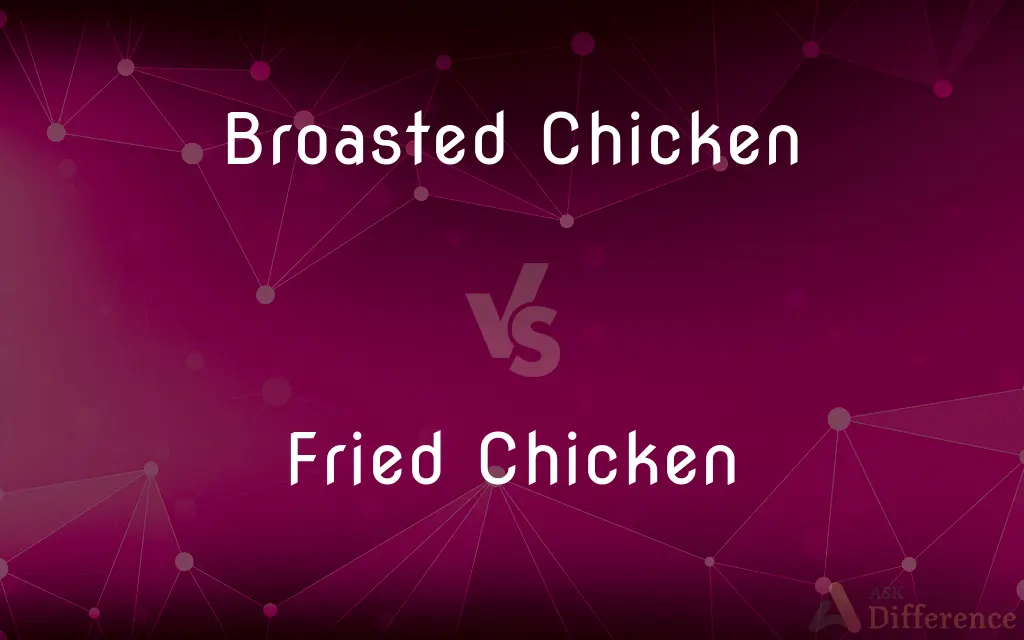Broasted Chicken vs. Fried Chicken — What's the Difference?
By Tayyaba Rehman & Urooj Arif — Published on March 7, 2024
Broasted chicken is cooked in a pressure fryer to retain moisture, while fried chicken is traditionally deep-fried, resulting in a crispier exterior.

Difference Between Broasted Chicken and Fried Chicken
Table of Contents
ADVERTISEMENT
Key Differences
Broasting combines frying and pressure cooking, using a special broaster to cook the chicken. This method seals in the chicken’s moisture while achieving a crispy exterior. Traditional fried chicken, however, is cooked in an open fryer or pan, allowing for a crunchier texture but potentially less moisture retention.
The cooking equipment differentiates the two methods: a broaster for broasted chicken and a deep fryer or skillet for fried chicken. The broaster cooks the chicken faster due to the high pressure, reducing the cooking time compared to the traditional frying method.
Broasted chicken often comes marinated and coated in a proprietary blend of seasoning before cooking, contributing to its unique flavor. Fried chicken recipes vary widely, with different herbs, spices, and coatings used to achieve a range of flavors and textures.
The texture of broasted chicken is tender and juicy inside due to the pressure cooking process, with a less greasy feel than traditional fried chicken. The latter often has a more pronounced crunch and can absorb more oil during the frying process, affecting its texture and flavor.
Nutritionally, broasted chicken might have a slight edge in retaining moisture and potentially less oil absorption due to the sealed environment of pressure frying. However, the nutritional value can vary significantly based on the recipe, including the type of oil used, the batter, and the chicken parts cooked.
ADVERTISEMENT
Comparison Chart
Cooking Method
Pressure frying
Open frying
Equipment Used
Broaster
Deep fryer or skillet
Texture
Tender inside, crispy outside
Uniformly crispy
Flavor
Often marinated with proprietary spices
Wide range of flavors based on spices and coatings
Nutritional Aspect
Potentially less oil absorption
Can be greasier due to oil absorption
Compare with Definitions
Broasted Chicken
Less greasy than traditional fried chicken.
Many prefer broasted chicken for its lower grease content.
Fried Chicken
Typically has a crunchier texture than broasted chicken.
Fans of fried chicken rave about its satisfying crunch.
Broasted Chicken
A cooking method using a pressure fryer to seal in moisture.
Broasted chicken offers a juicy interior with a crispy crust.
Fried Chicken
Can be seasoned in various ways for different flavors.
The chef used a secret blend of herbs for the fried chicken.
Broasted Chicken
Typically marinated and seasoned before cooking.
The broasted chicken's flavor comes from a special marinade.
Fried Chicken
Coating varies from flour to breadcrumbs.
The fried chicken was coated in a mixture of flour and spices.
Broasted Chicken
Known for its tender and moist texture.
The tenderness of broasted chicken sets it apart from other cooking methods.
Fried Chicken
Prepared by deep-frying in oil, resulting in a crispy texture.
Fried chicken is celebrated for its golden, crunchy exterior.
Broasted Chicken
Cooked faster due to high pressure.
Broasted chicken is ready quicker, thanks to the pressure cooking process.
Fried Chicken
More prone to oil absorption during cooking.
Fried chicken's crispy texture comes at the cost of absorbing more oil.
Common Curiosities
What makes broasted chicken different from fried chicken?
Broasted chicken is cooked in a pressure fryer, sealing in moisture, while fried chicken is deep-fried for a crunchier texture.
Is broasted chicken healthier than fried chicken?
Broasted chicken may absorb less oil due to the cooking process, potentially making it a slightly healthier option.
How does the cooking time compare between broasted and fried chicken?
Broasted chicken typically cooks faster due to the high pressure, while fried chicken takes longer in an open fryer.
Why is fried chicken so crispy?
The open frying method allows the exterior to become uniformly crispy due to direct contact with hot oil.
Can I make broasted chicken at home?
Without a commercial broaster, achieving the exact texture and moisture level of broasted chicken at home is challenging.
What are the key ingredients in a fried chicken coating?
Common ingredients include flour, salt, pepper, and other spices, with variations including buttermilk or egg wash for adherence.
Is broasted chicken available at most restaurants?
Broasted chicken is less commonly found than fried chicken, often available at specialized or chain restaurants.
Do broasted chicken and fried chicken use the same type of coating?
No, broasted chicken often uses proprietary coatings, while fried chicken coatings can vary widely in ingredients and texture.
Why does broasted chicken seem less greasy?
The pressure frying method used in broasting helps to seal the chicken's moisture, reducing oil absorption.
Which is more popular, broasted chicken or fried chicken?
Popularity varies by region and personal preference, with fried chicken being widely beloved for its classic texture and flavor.
Can I use any chicken part for broasting or frying?
Yes, both methods can be applied to any chicken part, but cooking times may vary based on size and thickness.
Is there a taste difference between broasted and fried chicken?
Yes, due to differences in cooking methods, coatings, and seasonings, the taste can vary significantly between the two.
What's the best way to reheat broasted or fried chicken?
Reheating in an oven or toaster oven is best to maintain the texture, avoiding the microwave which can make it soggy.
How do I know if chicken is broasted correctly?
Properly broasted chicken is juicy inside with a crispy exterior and should not feel overly greasy.
Can the oil type affect the taste of fried chicken?
Yes, the type of oil used can influence the flavor and healthiness of fried chicken, with options ranging from vegetable to peanut oil.
Share Your Discovery

Previous Comparison
Eufy Doorbell vs. Ring Doorbell
Next Comparison
Ventricular Tachycardia vs. Ventricular FibrillationAuthor Spotlight
Written by
Tayyaba RehmanTayyaba Rehman is a distinguished writer, currently serving as a primary contributor to askdifference.com. As a researcher in semantics and etymology, Tayyaba's passion for the complexity of languages and their distinctions has found a perfect home on the platform. Tayyaba delves into the intricacies of language, distinguishing between commonly confused words and phrases, thereby providing clarity for readers worldwide.
Co-written by
Urooj ArifUrooj is a skilled content writer at Ask Difference, known for her exceptional ability to simplify complex topics into engaging and informative content. With a passion for research and a flair for clear, concise writing, she consistently delivers articles that resonate with our diverse audience.
















































